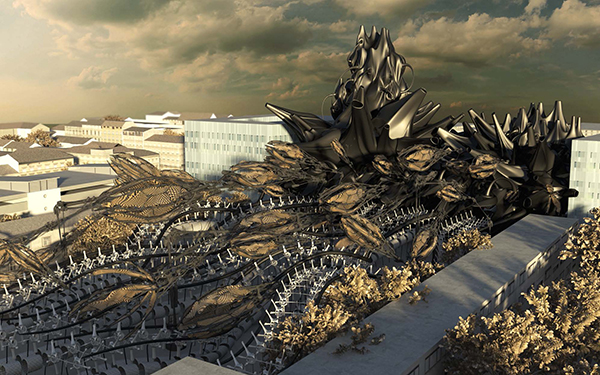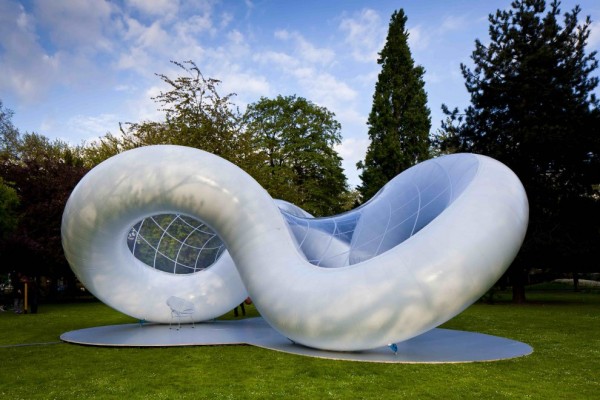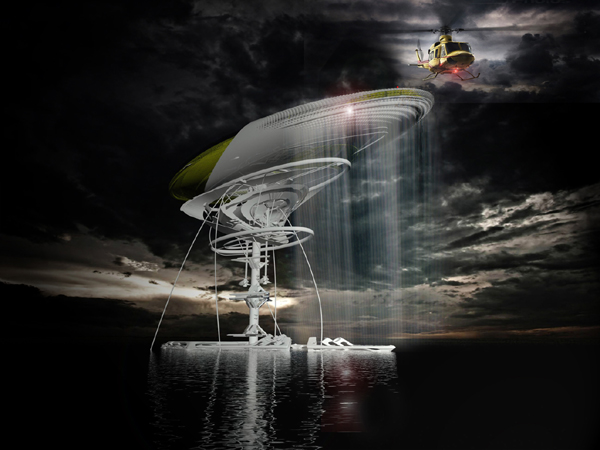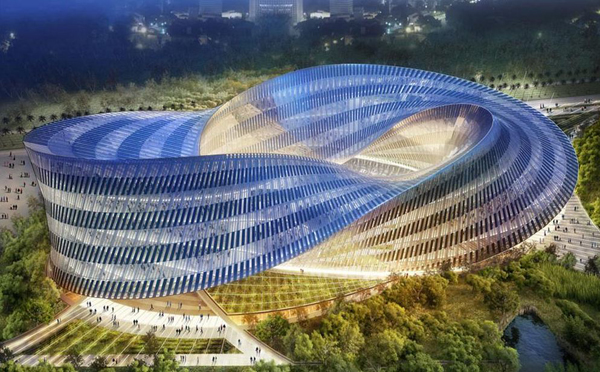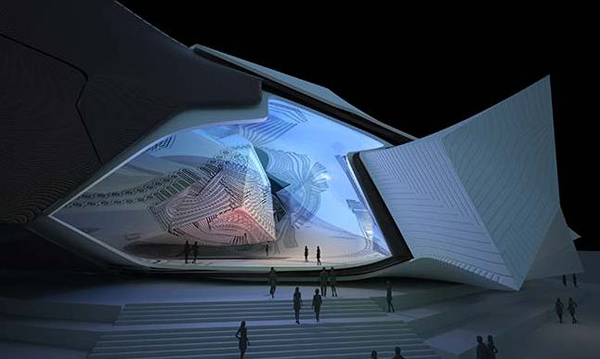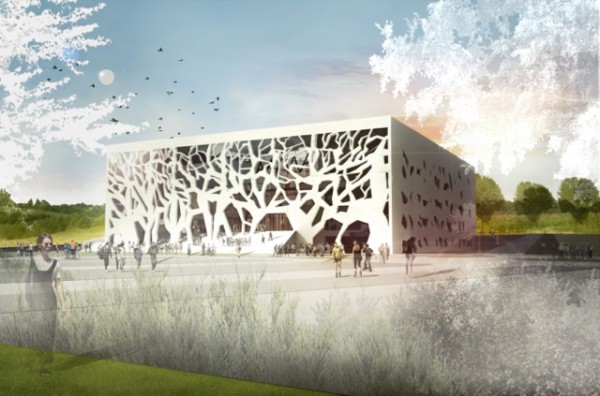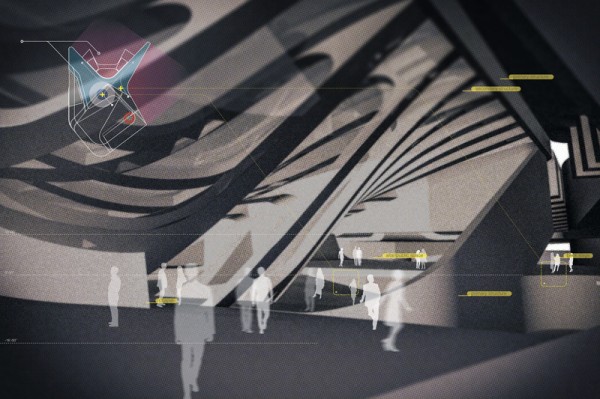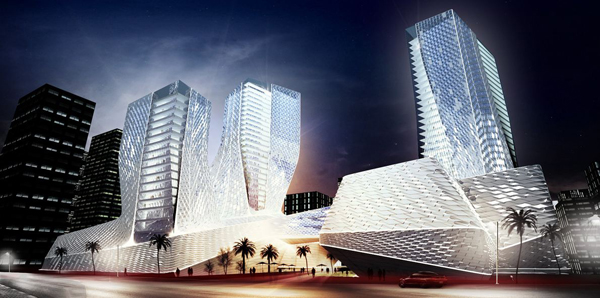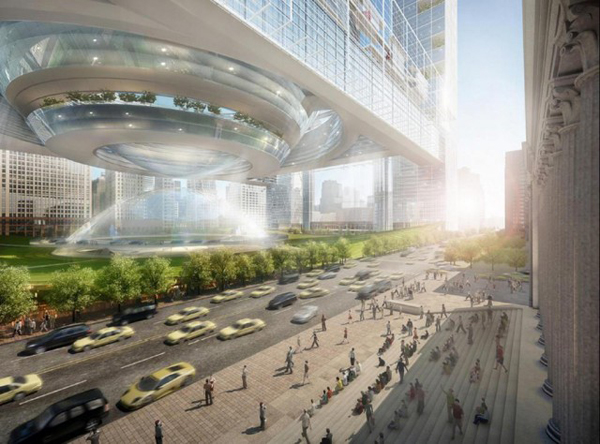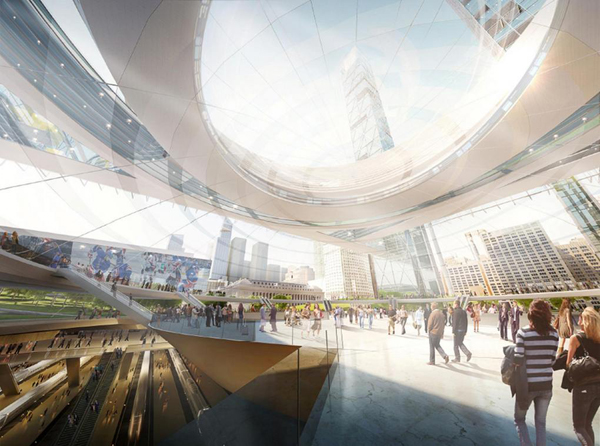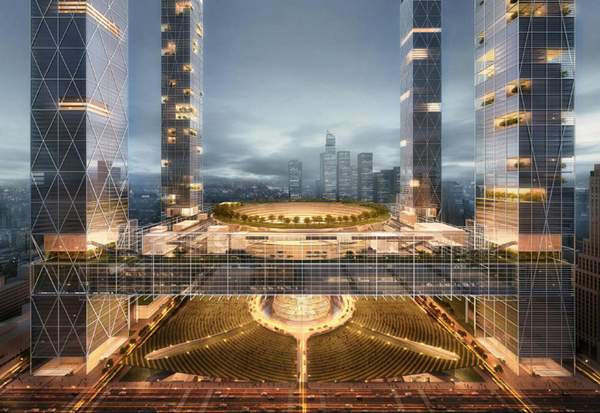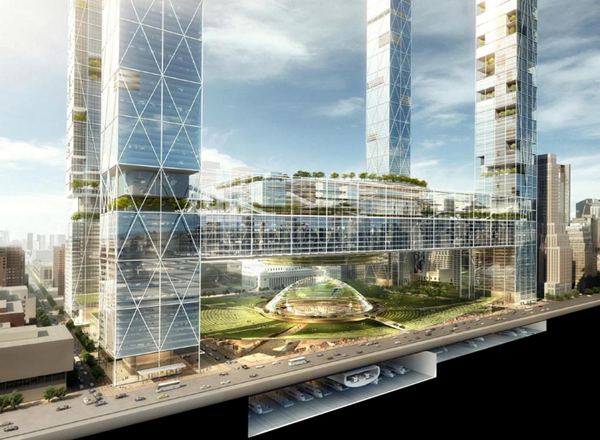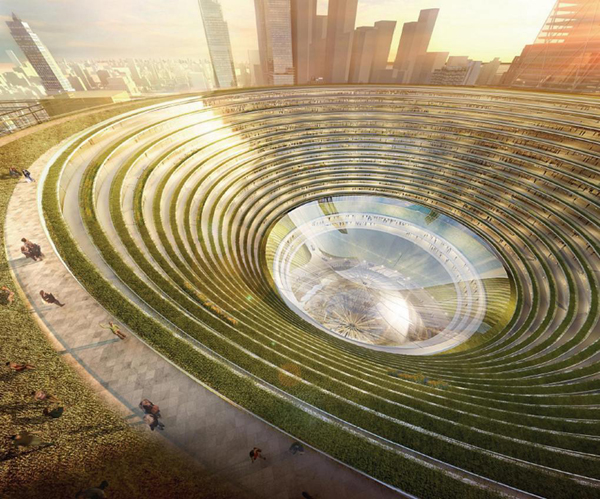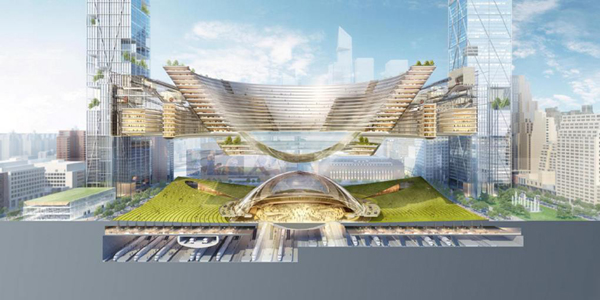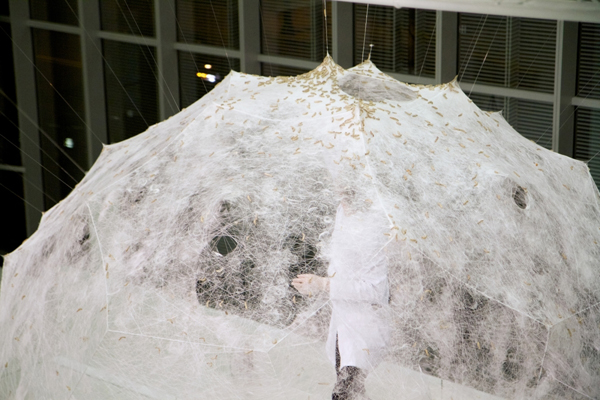Feiyu Qi at the University of Applied Arts in Vienna aimed to design a new train station for Vienna by reinterpreting the existing Westbahnhof station. In terms of the aesthetics and the form, there is a psychological disease called Trypophobia which would cause visitors with it to fear the clusters of small, similar shapes and holes. Read the rest of this entry »
Temporary Parametric Inflated Structure Wins the Triumph Pavilion Competition In London
Paris-based practice Atelier Zündel Cristea won the Triumph Pavilion – London competition and gained the opportunity to build their first prize proposal. Peace Pavilion was open to public at London’s Bethnal Green, Museum Gardens.
The architects at Atelier Zündel Cristea aimed to propose a pavilion that is visually and aesthetically engaging. The inflatable structure of this temporary exhibition piece provides an ideal contemporary space, while offering a sense of tranquility, beauty and aesthetic value, as a center-piece of the Museum Gardens in London. The authors were driven by strong belief that the peace is one of the highest human ideals – as a state of equilibrium, peace means no war, but harmony, silence, pureness, kindness, happiness, appeasement, calm, reconciliation and serendipity.
The structure of the pavilion is perfectly symmetrical; the form is obtained by precise geometrical manipulation. The very beauty and smoothness of the shape lies in its perfect fluidity and symmetry and the pavilion is open to everyone. The fluid geometry of this temporary structure blurs the transition from inside to outside, so the act of moving through the space is blurry and deceiving.
The structure is self-supporting, with 4 meters in height and 20 sqm in area, and it is designed entirely in lightweight materials – 77.96m² of PVC membrane and 20m3 of air. Read the rest of this entry »
Hydroelectric Waterfall Prison In The Pacific
Margot Krasojevic presents a a prison located in the Pacific Ocean close to the Canadian coastline. The main program is a sustainable prison which acts as a hydroelectric power station. Constructed of steel reinforced concrete, its vertical structure consists of a floating tension-leg platform tethered to the seabed eliminating most vertical movement, with depths up to 2,000m.
The concrete support is connected to 4-column semi-submersibles further stablized by floating Tyson turbines. The prison consists of a series of cantilevered loops creating an even weight distributed throughout the rig. The contained prison surface is made from a web of reinforced steel elements embedded within holographic filtered glass panels, superimposing views of life inside and views out of the prison, this depth of field creates a surreal environments which gives the illusion of boundary-less architecture, a kaleidoscopic panopticon. Read the rest of this entry »
Swallow’s Nest For Taichung / New Cultural Center By Vincent Cellebaut
Swallow’s nest is a new architectural icon, dedicated to the Fine Arts and Literature, designed by Vincent Cellebaut. It is a showcase of spatial versatility and cultural eclecticism. This crystal-like building is located on the site of the old Taichung airport, and represents a true gate to the new urban ecosystem. To be precise, the actual shape of the center is three-dimensional Mobius’ ring that extrudes its triangular section around the elliptic path. It might seem complicated, but the geometry is derived from simple repetition of a typical section – an isosceles triangle, made with three great tubular beams forming an arch. Inspired by nature, this organic form grows harmoniously as a plant from earth to the sky, according to its architect. The twist at 360 degrees of the three faces of the triangle is designed under the shape of three ruled surfaces, easily adjusted and de-composable into flat panels, ensuring pragmatic feasibility and a better cost control.
The project of Taichung’s cultural center aims to be a pioneer project which would represent the symbiosis of the natural and artificial, regarding its eco and bio-climatic design, renewable energies and state-of-the-art technologies of information and communication. The focus is also on spatial flexibility, as a key for successful and durable design and zero carbon emission. Read the rest of this entry »
Collider Activity Center Rethinks The Necessity Of A Building As A Neutral Container
Tom Wiscombe Design has done a proposal for Walltopia – Collider Activity Center – a brand center and a destination for sports and recreation. The project is designed for Bulgaria, and the author strongly believes that it was necessary to rethink the status of the building as a neutral container of active furnishings in favor of building as an active participant and distinct.
The primary idea was to take the concept of “boulders” produced by Walltopia and then reinterpret them as architectural objects. The form of the building is conceived in play of three-dimensional climbing surfaces. The final outcome is the abstract and alien space, yet a contemporary climber’s paradise.
The designed is derived from the formal and organizational model of objects in objects, which is in opposition to architecture as a single-skin container and to architectural hierarchies of enclosure and usual internal subdivisions through corridors and walls. Due to the chosen model, the building is wrapped in three layers – outer skin, sub-skin and a liner. Inspired by Borromini and Baroque architecture, these skins allow separate management of exterior and interior spaces. The layers vary in material quality and they are articulated differently. The skins sometimes track each other, but usually they have completely separate lives. Read the rest of this entry »
ANIMA | The First Project By Bernard Tschumi In Italy
Last week in Grottammare, Italy, the schematic design for ANIMA was unveiled, the first work in Italy by renowned firm Bernard Tschumi Architects, commissioned by the Fondazione Cassa di Risparmio di Ascoli Piceno and the Municipality of Grottammare.
ANIMA is a cultural center that will be built in Grottammare, a city in the province of Ascoli Piceno, intended to generate stronger ties between the people and the territory. The concept intends to associate its image to the most diverse manifestations of local culture, which find expression through artistic, gastronomic and environmental means. In addition to elaborating with immense precision and originality the theme by which the interior spaces are organized, Tschumi has proposed an artifact that reworks the notion of facade as an indispensable tool with which to reconfigure space. Oscillating between the figuative and the abstract, the building reinforces the identity of the region at even its conceptual stage. Read the rest of this entry »
Mega Church In Garden Grove, California
Cheng Gong of the Southern California Institute of Architecture in Los Angeles designed this edifice while keeping in mind the values preserved in the churches created by Richard Meier, Richard Neutra, and Philip Johnson. As a respect to the existing slope of Meier’s church, the site design extends beyond the landscape and benefits it as the seating area of an “amphitheatre church”; the entrance is also shaped following the slope direction, as visitors are intended to be received at a lower level. As a response to the “drive-in” program of Neutra’s church as well as to preserve this California moto culture, drive-in parking lots are kept at the same location. Comparing to Johnson’s crystal mega church, which stands out isolated from the site, this church chooses a low-profile gesture with the same height of Meier’s building, producing an alternative standpoint with stronger communication with the surroundings.
Architecture In Movement For Shanghai Wuzhou International Plaza / SDA
Synthesis Design + Architecture were awarded the first place in the invited international design competition for the Shanghai Wuzhou International Plaza, in collaboration with Shenzhen General Institute of Architectural Design and Research and FLVR Studio. Primary intent of the designers of this winning proposal was to unify the various programs, buildings and the parcels into one single and cohesive identity. The proposed development is vibrant and vivid, embodying the energy of Shanghai’s distinct urban environment.
The very form of this unique development was inspired by the flowing ribbons and choreographed movements of Chinese traditional Ribbon dances. The proposal aimed to capture the elegance of the flowing ribbons and to design the structure as a choreographed and synchronized composition of dancing surfaces which are unified, peel apart and are in constant movement, rather than a collage of singular objects.
The actual architecture emerges in space between the dancing objects and surfaces. The project is an articulation of diverse, dynamic bands, which simultaneously wrap the two created podiums, connecting two sites in the form of connective sky bridges and defining a unifying external courtyard, merging the horizontal with the vertical office towers. Read the rest of this entry »
SOM’s Dramatic Proposal For Penn Station And Madison Square Garden
Four architectural practices were challenged recently to re-envision New York’s Penn Station and Madison Square Garden, in order to create more livable city through intelligent urban planning and design. Four designs have been revealed, proposing fresh and improved biggest transit hub in the western hemisphere, and are focused on smart solutions for pedestrians as well as on the impact of built form to the transit access.
Skidmore, Owings & Merrill LLP (SOM), the renowned architecture, engineering, interiors and urban-planning firm, revealed its proposal. SOM was invited to contribute because of its long history of working in Manhattan, its wide-ranging expertise on extraordinarily complex sites and issues. Their plan dramatically expands the transit capacity at Penn Station – it calls for the expansion of Penn Station’s footprint by two additional blocks, in order to accommodate high-speed rail lines for the Northeast Corridor, expanded commuter rail service for the entire tri-state area, and direct rail connections to JFK, LaGuardia and Newark Airports.
The vision for the very station is very intuitive and open – the transparent Ticketing Hall is placed at the center of the site, surrounded by the radial pedestrian connections to the city. Two concourses directed north-south seamlessly enable passengers to move from ground level to level below.
The proposed design fully exhausts the potential air rights yet preserving the full four block ground-plane, for public use. The architects at SOM believe that, in order to reach its full unrealized potential, the site must be the civic heart of Midtown West. Aiming to optimize one of the largest multi-modal stations in the world, SOM provides to build public Park, four times larger than Bryant Park, a commercial development the size of Rockefeller Center, a city of Culture larger than Lincoln Center, and a residential neighborhood the size of Tudor City.
Silk Pavilion: An Outcome Of Computational Form-Finding At MIT Lab
Inspired by the way silkworms weave delicate cocoons from a single strand of silk, the Silk Pavilion is created using a base of robot-woven threads. Created by The Mediated Matter group, focused on biologically inspired design fabrication tools and technologies, the pavilion explores the relationship between digital and biological fabrication on both architectural and product scales. The primary structure of this unique and fragile pavilion was created of 26 polygonal panels, made of silk treads laid down by a CNC machine.
The research of the Mediated Matter group aims to integrate computational form-finding strategies with biologically inspired fabrication and the pavilion is the outcome of a process. They strongly believe in the importance of this research, therefore enabling mediating synergies between objects and environment, between humans and objects, and between humans and environment, which would enhance the relation between natural and artificial environments by ensuring higher levels of versatility and customization, material efficiency and environmental performance integration.
The geometry of the pavilion is created using an algorithm assigning a single continuous thread across patches, therefore providing various degrees of density. The overall density was further informed by the silkworm itself, as a biological printer creating the secondary structure. A swarm of 6,500 silkworms was positioned at the bottom rim of the scaffold spinning flat non-woven silk patches, locally reinforcing the gaps across CNC-deposited silk fibers. The migration of silkworms was directed by light conditions due to spatial and environmental conditions, including geometrical density and variation in natural light and heat. Read the rest of this entry »

